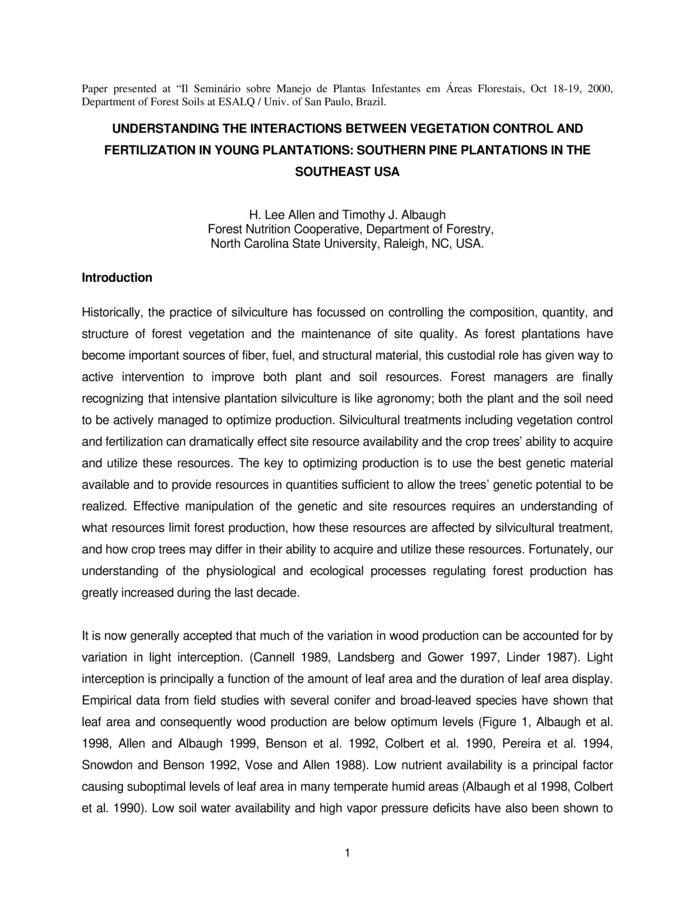PDF
Understanding the Interactions between Vegetation Control and Fertilization in Young Plantations: Southern Pine Plantations in the Southeast USA Item Info
- Title:
- Understanding the Interactions between Vegetation Control and Fertilization in Young Plantations: Southern Pine Plantations in the Southeast USA
- Creator:
- Allen, H.L.; Albaugh, T.J.
- Date Created (ISO Standard):
- 2000-10-18
- Description:
- Historically, the practice of silviculture has focussed on controlling the composition, quantity, and structure of forest vegetation and the maintenance of site quality. As forest plantations have become important sources of fiber, fuel, and structural material, this custodial role has given way to active intervention to improve both plant and soil resources. Forest managers are finally recognizing that intensive plantation silviculture is like agronomy; both the plant and the soil need to be actively managed to optimize production. Silvicultural treatments including vegetation control and fertilization can dramatically effect site resource availability and the crop trees' ability to acquire and utilize these resources. The key to optimizing production is to use the best genetic material available and to provide resources in quantities sufficient to allow the trees' genetic potential to be realized. Effective manipulation of the genetic and site resources requires an understanding of what resources limit forest production, how these resources are affected by silvicultural treatment, and how crop trees may differ in their ability to acquire and utilize these resources. Fortunately, our understanding of the physiological and ecological processes regulating forest production has greatly increased during the last decade. It is now generally accepted that much of the variation in wood production can be accounted for by variation in light interception. (Cannell 1989, Landsberg and Gower 1997, Linder 1987). Light interception is principally a function of the amount of leaf area and the duration of leaf area display. Empirical data from field studies with several conifer and broad-leaved species have shown that leaf area and consequently wood production are below optimum levels (Figure 1, Albaugh et al. 1998, Allen and Albaugh 1999, Benson et al. 1992, Colbert et al. 1990, Pereira et al. 1994, Snowdon and Benson 1992, Vose and Allen 1988). Low nutrient availability is a principal factor causing suboptimal levels of leaf area in many temperate humid areas (Albaugh et al 1998, Colbert et al. 1990). Low soil water availability and high vapor pressure deficits have also been shown to adversely affect leaf area in areas with growing season water deficits (Benson et al. 1992, Hennessey et al. 1992, Pereira et al. 1994). The variation in production per unit of leaf area (referred to as growth or leaf area efficiency) can also contribute to the variation in production. Growth efficiency can vary due to differences in photosynthetic efficiency, respiration, and partitioning to various biomass components. Improved nutrient and water availability has been shown to increase photosynthetic efficiency (Linder 1987) and aboveground productivity proportionally more than belowground productivity in stand-level studies (Albaugh et al. 1998, Allen and Albaugh 1999, Gower et al. 1994).
- Subjects:
- research (document genres) forest management
- Location:
- North and Central Idaho; Eastern Washington; Western Montana; Northeastern Oregon
- Publisher:
- Department of Forest Soils at ESALQ / Univ. of San Paulo, Brazil
- Source:
- Allan, H.L. and T.J. Albaugh.2000. Understanding the Interactions Between Vegitation Control and Fertilization in Young Plantations: Southern Pine Plantations in the Southeast USA. Paper presented at Il Seminario sobre Manejo de Plantas Infestantes em Areas Florestais, Department of Forest Soils at ESALQ/ Univ. of San Paulo, Brazil. Oct 18-19, 2000 p: 1-14
- Source Identifier:
- Understanding_Interactions_Between_Veg_Control+Fertilization_Young_Plantations_S_Pine_Plantations_SEUSA_ESALQ_2000
- Type:
- Text
- Format:
- application/pdf
- Language:
- eng
Source
- Preferred Citation:
- "Understanding the Interactions between Vegetation Control and Fertilization in Young Plantations: Southern Pine Plantations in the Southeast USA", Idaho Forestry Research Collection, University of Idaho Library Digital Collections, https://www.lib.uidaho.edu/digital/forestryresearch/items/forestryresearch917.html
Rights
- Rights:
- In copyright, educational use permitted. Educational use includes non-commercial reproduction of text and images in materials for teaching and research purposes. For other contexts beyond fair use, including digital reproduction, please contact the University of Idaho Library Special Collections and Archives Department at libspec@uidaho.edu. The University of Idaho Library is not liable for any violations of the law by users.
- Standardized Rights:
- http://rightsstatements.org/vocab/InC-EDU/1.0/

